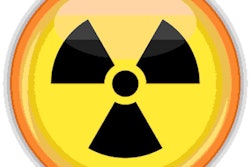
In a large multicenter study of thrombectomies carried out over three years, a French-led group has demonstrated that a coherent approach to radiation dose reduction can bring substantial benefits. They published their findings in European Radiology online on 22 March.
Using radiation dose-reduction systems can reduce dose area product (DAP) by a third and air kerma by a half, without affecting thrombectomy efficacy or safety in the setting of acute ischemic stroke due to large-vessel occlusion, according to noted lead author Dr. Adrien Guenego, from the interventional neuroradiology department at Pierre-Paul Riquet Hospital, Toulouse University Hospital, and colleagues.
"International dose reference levels are lacking for mechanical thrombectomy in acute ischemic stroke patients with large-vessel occlusions," they noted. "Internationally validated achievable levels may help caregivers and health authorities better assess and reduce radiation exposure of both ischemic stroke patients and treating staff during thrombectomy procedures."
Therefore, the researchers investigated whether radiation dose-reduction systems could effectively reduce exposure and propose achievable levels. They retrospectively included consecutive patients treated with thrombectomy on a biplane angiography system in five international, high-volume centers. They compared efficacy, safety, radiation dose, and contrast load between angiography units, with and without dose-reduction systems.
Patient selection
Between January 2014 and May 2017, 1,426 thrombectomies were performed at the five facilities. After excluding procedures performed on single-plane units (302 interventions, which will be the focus of a future study) or with incomplete dose reports (28 procedures due to faulty automatic transmission, file corruption, or premature shutdown of the machine during transfer to the PACS), 1,096 patients remained for analysis. Dose-reduction systems were used in 520 cases. No major difference was found in baseline characteristics between patients treated with or without dose reduction.
The mean age, weight, and National Institutes of Health Stroke Scale of patients were, respectively, 70 years (range, 18-101; median, 72 [59-82]), 77 kg (range, 38-142; median, 75 [65-86]), and 17 points (range, 0-33; median, 17 [12-21]). Of the cohort, 556 (51%) were women.
"DAP is a surrogate measure of the amount of energy delivered to patients, while air kerma is the dose accumulated at the patient entrance reference point," explained Guenego and his colleagues. "Since these parameters vary from one practice to another, specifications and technical parameters of each angiosuite were obtained from the radiophysic department of all participating centers and reviewed by two radiophysicists. All dose reports were extracted from the different picture archiving systems by a local interventional neuroradiologist and/or physicist in each center."
Calibration of the DAP was regularly performed by the two main angiosuite vendors involved (Philips Healthcare and Siemens Healthineers), and measurements were obtained according to international standards. A 27- or 32-cm field-of-view was used for the vast majority and during most of the procedures. The researchers did not measure the exact percentage of cases when collimation was applied, but a "systematic and usual approach" was used in all centers for fluoroscopy and angiographic runs to limit exposure.
Key findings
Of the 1,096 thrombectomized patients, 520 (47%) were treated on a biplane system equipped with dose-reduction technology. After multivariate analysis, dose-reduction systems significantly cut DAP (91 Gy cm2 versus 140 Gy cm2; relative effect, 0.74 (confidence interval [CI], 0.66-0.83); 35% decrease; p < 0.001) and air kerma (0.46 Gy versus 0.97 Gy; relative effect, 0.63 (CI, 0.56-0.71); 53% decrease; p < 0.001) with 75th percentile levels of 148 Gy cm2 and 0.73 Gy, respectively. There was no difference in contrast load, rates of successful recanalization, complications, and clinical outcome.
Overall, use of dose-reduction systems in thrombectomy resulted in a 35% decrease in DAP and 53% in air kerma. The systems did not affect the rate of successful recanalization, complication, or good clinical outcome at three months.
Using the 75th percentile of DAP and air kerma in the cohort of thrombectomy patients treated on a biplane dose-reduction system, the researchers obtained achievable levels of 148 Gy cm2 and 0.73 Gy, respectively, which may serve to optimize current and future radiation exposure in the setting of endovascular acute ischemic stroke treatment, they pointed out.
"As technology evolves, we expect these values to decrease," the authors concluded.



















